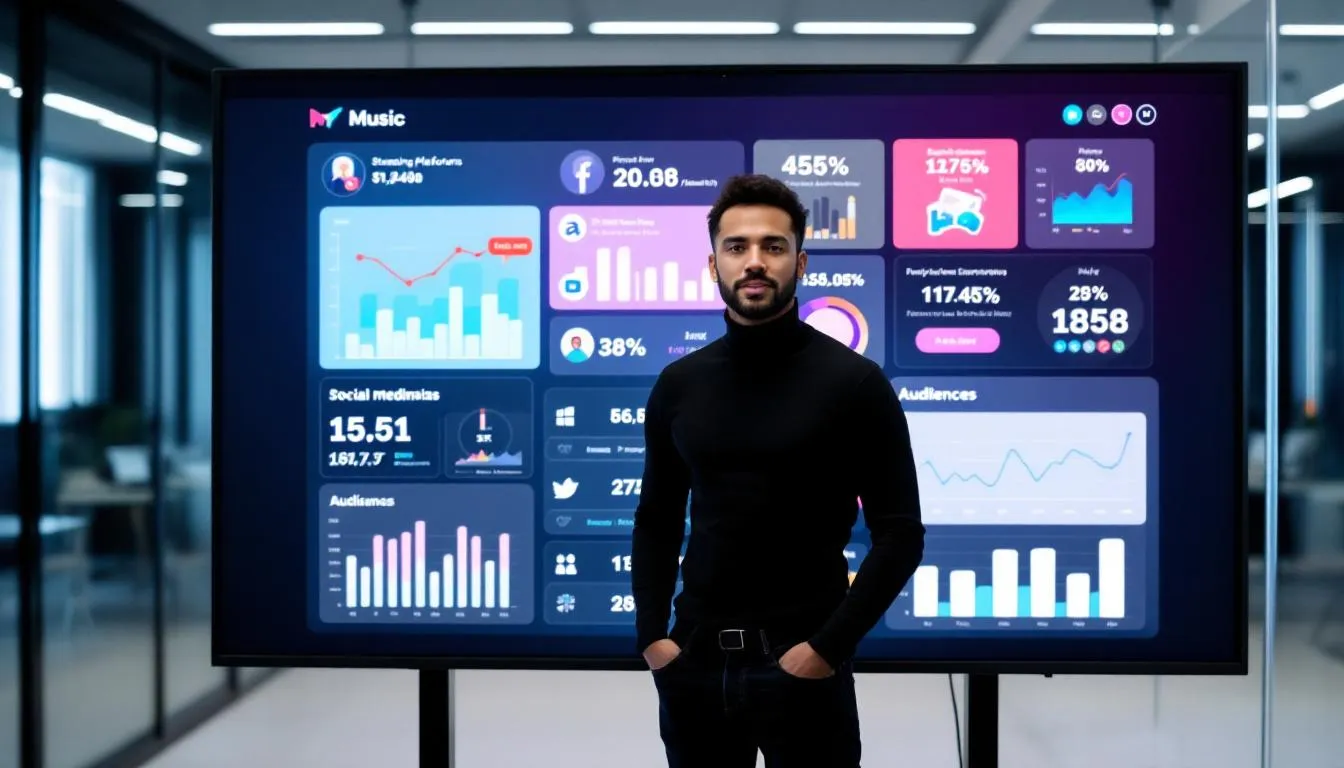For independent artists in 2025, the dream isn’t just to make music—it’s to get it heard. But with so many streaming platforms, digital stores, music stores, and competing artists, the path to visibility can feel overwhelming. The good news? You no longer need a label deal or hefty upfront costs to share your music with the world, reach music worldwide, and connect with fans across the globe. Thanks to free music distribution platforms, it’s possible to distribute music for free and reach Spotify, Apple Music, YouTube, Tidal, Deezer, and more—without breaking your budget.
This guide explores everything you need to know about using a free music distributor. From how these platforms work, you can distribute your music as singles, albums, or EPs—these platforms support both individual tracks and full albums, making it easy to release an entire album without extra costs. You can get your music onto major platforms quickly and easily, and join thousands of independent artists already using these services. We’ll cover how independent artists can maximize reach, keep their rights, and still earn royalties—all while spending $0 upfront. These platforms are transparent, with no hidden fees compared to other distributors, and allow you to distribute your music globally, helping you reach listeners across the globe. Unlike some other distributors, these platforms offer free distribution without hidden fees.
Why Free Music Distribution Matters in 2025
The music industry has transformed. In the past, artists needed record labels for physical distribution—CDs, vinyl, tapes. Today, digital distribution puts your track in the ears of global listeners instantly.
But here’s the catch: most distributors charge either upfront fees or annual subscriptions, and even some free platforms may not be as transparent as other distributors. Some distributors also include hidden fees that can catch artists by surprise. For a rising artist with no guarantee of streams, paying $20–$50 per release can be a huge barrier. This is why free music distribution services are becoming essential—they let artists upload and distribute without financial risk.
Free distribution platforms democratize the industry. Anyone with talent and consistency can upload a song, reach Spotify playlists, and you can also distribute full albums to music stores and streaming platforms, and start building momentum—without relying on gatekeepers.

What Is Free Music Distribution?
Free music distribution means you can distribute your music and get your music onto major platforms easily by releasing your tracks to streaming platforms and digital stores without paying fees upfront. Instead of charging artists directly, free distributors often take a percentage of royalties (commonly 10–20%). Others offer hybrid models where distribution is free, but extra services like playlist pitching or promotion cost money. Importantly, artists keep 100% of their music ownership when using these services, ensuring full creative control over their work.
Here’s what typically happens when you use a free music distributor:
- Upload your music – You provide your song in WAV/MP3, plus metadata (title, artist name, cover art). You can upload singles, albums, or EPs, and the platform supports full album releases.
- Choose platforms – Select where your track will appear (Spotify, Apple Music, Amazon Music, etc.), including music stores, Facebook, and YouTube.
- Release date – Set your launch day to align with your promo strategy.
- Get royalties – When fans stream or purchase your music, the distributor collects revenue and passes it on.
Most platforms have a review process to ensure quality and compliance before your music goes live.
Content ID systems on platforms like YouTube and Facebook can help you monetize your music when it’s used in user-generated videos.
A dedicated team at the distributor often handles support, moderation, and artist relations.
Benefits of Using Free Music Distributors
- Zero upfront risk – Perfect for new artists testing the waters.
- Global reach – Your track appears on the same platforms as major label artists.
- Keep creative control – Most free distributors don’t claim rights over your masters.
- Professional legitimacy – Having music on Spotify, Apple Music, and YouTube Music boosts your credibility.
- Revenue sharing – Even on a free plan, you still earn royalties for streams and downloads.
- Distribute singles and albums – Free distributors support the release of both singles and full albums, making it easy to distribute entire albums to music stores.
- Advance your music careers – These platforms provide tools and opportunities to help artists grow and develop their music careers.
- Dedicated team working hard – A dedicated team is constantly working hard behind the scenes to support artists and ensure smooth distribution.
Drawbacks of Free Music Distribution
While appealing, free distribution isn’t without limitations:
- Royalty cuts – Most free platforms keep a percentage of your earnings.
- Limited features – Some free plans exclude playlist pitching, fast payouts, or advanced analytics.
- Slow support – Free tiers often mean slower customer service, as limited team resources can lead to slower response times.
- Longer review process – Free platforms may have longer review times before your music goes live, as the review and approval process can take more time compared to paid options.
- Hidden upsells and fees – Many platforms lure you with “free” but push premium upgrades, and some other distributors may charge hidden fees, making transparency crucial.
That said, for indie artists starting out, the benefits usually outweigh the drawbacks.

The Best Free Music Distribution Platforms in 2025
Join thousands of independent artists who trust these platforms to distribute their music worldwide, reaching listeners across the globe. These services make it easy to expand your audience far beyond your local scene. Compared to other distributors, these platforms offer unique benefits such as transparent pricing and artist-friendly features.
Here’s a breakdown of the top free music distributors you should consider:
1. Amuse
- Model: 15% cut on royalties (Pro plan removes cut)
- Why use it: Clean mobile app, easy uploads, free releases. Amuse allows you to distribute both singles and full albums to major music stores.
- Best for: Artists who want free distribution with simple mobile control.
2. RouteNote
- Model: Free tier keeps 15% of royalties; paid tier gives you 100%.
- Why use it: Transparent royalty split, large store coverage. RouteNote allows you to distribute both singles and albums to a wide range of music stores. It also supports Content ID for monetizing your music on platforms like YouTube and Facebook, letting you earn revenue when your music is used in YouTube content and Facebook videos. Additionally, RouteNote allows artists to earn 85% of their music revenue when distributing for free.
- Best for: DIY artists happy to trade royalties for free distribution.
3. Soundrop
- Model: Free distribution, but takes $0.99 per cover song license and 15% royalties.
- Why use it: Popular with cover-song artists, sync-friendly platform. Soundrop supports the distribution of both singles and full albums to major music stores, making it easy for artists to release albums or individual tracks across multiple outlets.
- Best for: Musicians who release both originals and covers.
4. Boost Collective
- Model: Free distribution, revenue share model.
- Why use it: Combines distribution with artist marketing tools. Boost Collective allows you to distribute both singles and albums to a variety of music stores, making it easy to release an entire album or multiple albums without extra costs.
- Best for: Independent artists needing both distribution and growth.
5. UnitedMasters
- Model: Free plan with 10% royalty cut; premium plan lets you keep 100%.
- Why use it: Strong brand partnerships (NBA, ESPN), sync opportunities. UnitedMasters supports the distribution of both singles and full albums to major music stores, making it easy for artists to release albums or individual tracks across multiple platforms.
- Best for: Artists looking for commercial sync deals and exposure.
6. AWAL (limited access)
- Model: Free distribution for selected artists (invite only).
- Why use it: Professional tier services without fees. AWAL enables artists to distribute both singles and albums to a wide range of music stores, making it easy to release an entire album or multiple albums alongside individual tracks.
- Best for: Artists already gaining traction who want industry-level support.
Free vs Paid Music Distribution: Which Should You Choose?
The choice depends on where you are in your career:
- Free Music Distribution Platforms: Ideal for beginners testing audience reach. You don’t risk money but sacrifice a small percentage of royalties, unlike other distributors that may charge hidden fees or have less transparent pricing.
- Paid Services (like DistroKid or TuneCore): Best for established artists releasing frequently. Paying annually to keep 100% royalties often pays off if you earn consistent streams.

Step-by-Step: How to Distribute Music for Free
- Pick a Free Music Distributor
Choose from Amuse, RouteNote, UnitedMasters, or others based on your needs. These platforms make it easy to distribute your music and get your music onto major music stores and streaming platforms. - Prepare Your Files
Ensure your track is high-quality WAV or MP3, with proper mastering. Bad audio = rejection. You can upload singles, albums, or EPs—most platforms support full album releases so you can distribute multiple tracks together. - Design Cover Art
Most platforms require square (3000×3000 pixels). Use tools like Canva if you’re DIY. - Fill Metadata Correctly
Artist name, song title, genre, composer info. Metadata errors can delay your release. Accurate metadata is important for both singles and albums. - Set Release Date
Give at least 2 weeks lead time for playlist pitching. - Promote Your Release
Free distribution won’t market your music. Build buzz on TikTok, Instagram, and YouTube. Promote your music on Facebook and YouTube, and use content ID to help monetize your music on these platforms, including YouTube Content. - Collect Royalties
Most free distributors pay quarterly. However, some platforms offer monthly payouts, allowing artists to receive earnings consistently. Some also offer faster payouts via premium upgrades.
After submitting, your release will go through a review process—most platforms have a team that reviews submissions before they go live.
Tracking and Analytics: Measuring Your Music’s Reach
In today’s digital music landscape, understanding how your music performs is just as important as getting it out into the world. Effective music distribution isn’t complete without robust tracking and analytics tools that help independent artists measure their reach and impact.
A reliable music distributor will provide you with detailed insights into your streams, downloads, and earnings across major streaming services like Spotify and Apple Music. With free music distribution services, you can often access analytics dashboards that break down your audience by location, age, and listening habits. These features allow you to see which songs are resonating, where your listeners are based, and how your releases are performing over time.
Real-time streaming reports, earnings per stream, and geographical data empower musicians to make data-driven decisions. By analyzing these trends, you can refine your release strategies, focus your promotional efforts, and connect with your audience more effectively. Whether you’re planning your next single release or mapping out a tour, these analytics tools are essential for building a successful music career and growing your fan base worldwide.

Royalty Payments and Pricing: What to Expect from Free Distributors
When choosing a free music distribution service, it’s crucial to understand how royalty payments and pricing structures work. Most free music distributors operate on a revenue-sharing model, where you receive a percentage of the royalties generated by your music. Some platforms offer 100% royalty retention on certain plans, while others may take a small cut in exchange for free distribution.
Before releasing your music, always check for hidden costs, such as upfront fees, annual renewal charges, or additional service fees that could impact your earnings. Transparency is key—look for a music distributor that clearly outlines their royalty splits and any potential costs, so you can maintain full control over your music and finances.
Distributors like RouteNote provide flexible options, allowing you to choose between free and paid plans depending on your needs and career goals. By understanding the royalty payment process and pricing models, you can maximize your earnings, avoid surprises, and focus on building your music career with confidence.
Transferring Your Catalog: Moving Your Music Between Platforms
As your music career evolves, you might find the need to switch music distributors—whether for better royalty rates, more features, or improved support. Transferring your catalog doesn’t have to be complicated, but it does require careful planning to ensure your music remains available on major streaming services like Spotify, Apple Music, and YouTube.
To move your releases, you’ll typically need to provide key details such as UPC and ISRC codes, release titles, and artist names. This information ensures your tracks are correctly identified and seamlessly migrated to the new platform. A good music distributor will guide you through the process, minimizing downtime and helping you maintain your audience and earnings.
When considering a transfer, look for distributors that offer free unlimited distribution, support for unlimited releases, and access to advanced analytics. These features will help you keep control over your music, monitor your performance, and continue growing your fan base without interruption. By choosing the right partner, you can ensure your musical journey continues smoothly, no matter where your music is distributed.
Playlist and Marketing Support: Getting Your Music Heard
Getting your music onto streaming platforms is just the first step—standing out in a crowded world of releases requires effective playlist and marketing support. Many music distributors now offer tools and services designed to help independent artists boost their visibility and reach new listeners.
Look for distributors that provide playlist pitching opportunities, featuring your tracks on curated playlists across Spotify, Apple Music, and other major platforms. Some services also offer promotional tools like social media campaigns, email marketing, and collaborations with influencers or other artists, all aimed at expanding your audience and advancing your music career.
Priority support and access to industry professionals can make a big difference, especially when you’re navigating the complexities of music distribution and promotion. By leveraging these resources, you can amplify your musical journey, connect with more listeners, and increase your chances of success in the competitive music industry. Choose a distributor that not only gets your music online but also supports your growth every step of the way.
Maximizing Success with Free Music Distribution Services
Just uploading isn’t enough. To make free distribution work for you:
- Optimize your Spotify profile – Add artist bio, photos, and social links.
- Pitch to playlists – Even free artists can submit via Spotify for Artists.
- Leverage TikTok & Instagram Reels – Short-form video can drive streams.
- Build an email list – Don’t rely only on algorithms; own your fanbase.
- Engage on YouTube – Upload lyric videos, behind-the-scenes, or live sessions.
- Advance your music career – Free distribution services can help you build and grow your music career by providing access to global platforms and essential tools.
- Work hard to promote your music – Success comes from working hard to take advantage of every opportunity and tool available to you.
- Rely on a dedicated team for support – Many platforms offer a support team to help artists succeed and navigate challenges along the way.
Common Myths About Free Music Distribution
- “Free means low quality.”
False. Many charting artists started with free distribution platforms. Free does not mean less transparent—unlike some other distributors, free platforms can actually be more upfront about costs, with no hidden fees or surprise charges. - “You lose your rights.”
False for most. Free distributors typically don’t take ownership of your masters. - “It’s only for beginners.”
False. Even mid-level indie artists use free platforms strategically.
The Future of Free Music Distribution
As competition grows, expect distributors to innovate. We’re already seeing:
- AI-driven playlist pitching – Helping songs land placements more effectively.
- Faster payouts via crypto or fintech integrations.
- More sync licensing opportunities – Linking free distribution with brand deals.
- Community-based platforms – Where distribution also builds networking among artists.
Distribution platforms will continue working hard to support artists and their music careers, with dedicated teams driving innovation and helping artists achieve long-term success.
For independent artists, the future looks brighter than ever.
